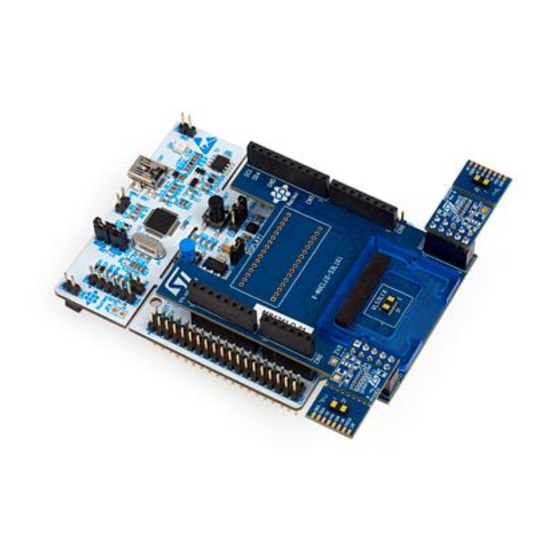Table of Contents
Advertisement
UM2600
User manual
Counting people with the VL53L1X long-distance ranging Time-of-Flight sensor
Introduction
This user manual explains how to use a VL53L1X long-distance ranging Time-of-Flight (ToF) sensor to count people crossing a
specific predefined area, like a meeting room entrance or a particular location in a corridor. It also describes an algorithm used
to count the people. The algorithm is provided as an example and can be downloaded from st.com, in the VL53L1X embedded
SW section, under the reference STSW-IMG010.
In addition, this document presents the details of a counting application where a sensor is set on the top, not the side, of the
area to be tracked.
UM2600 - Rev 2 - December 2020
www.st.com
For further information contact your local STMicroelectronics sales office.
Advertisement
Table of Contents

Summary of Contents for ST VL53L1X
- Page 1 It also describes an algorithm used to count the people. The algorithm is provided as an example and can be downloaded from st.com, in the VL53L1X embedded SW section, under the reference STSW-IMG010.
-
Page 2: Acronyms And Abbreviations
UM2600 Acronyms and abbreviations Acronyms and abbreviations Table 1. Acronyms and abbreviations Acronym/abbreviation Definition field of view SPAD single photon avalanche diode software Time-of-Flight UM2600 - Rev 2 page 2/15... -
Page 3: Overview
Overview Overview Counting people with the VL53L1X consists of using the multiple zones of the sensor receiving SPAD area, and of configuring it with two distinct fields of view (FoV), to alternatively get a ranging distance from them and consequently recognize the movements of a person. Using this method, the number of people occupying a meeting room, accessible from a reasonably narrow access, is known at all times by detecting the entrances and exits of the attendees. -
Page 4: Algorithm Description
UM2600 Algorithm description Algorithm description The counting algorithm example relies on a list of states that have to occur in a certain order to detect if a person has crossed the specified area and in which direction this area has been crossed. These states are stored in a list and compared to two default lists of states that represent how the area is crossed in two different directions. -
Page 5: Hysteresis
UM2600 Hysteresis Hysteresis The algorithm validates a crossing event only when a person has fully crossed the two zones. It does not validate the event when the person remains for a long time under the FoV or when the person decides to return from the place he came from. -
Page 6: Vl53L1X Sensor And Algorithm Configuration
VL53L1X sensor and algorithm configuration It is sufficient to set the two FoVs by dividing the 16*16 SPAD array of the VL53L1X sensor into two sub N*16 arrays. For example, N can be chosen within the interval [4, 8]. This means that it is not necessary to use the same SPADs for front and back ranging. -
Page 7: Setup Reliability
UM2600 Setup reliability Setup reliability Ranging on the floor to determine the threshold Reliability of the algorithm relies on the accuracy of the setup which detects the distance between the sensor and the floor. This can be ensured only if nothing (e.g. no obstacle or static object) blocks the front and back FoVs. - Page 8 UM2600 Ranging on the floor to determine the threshold Figure 9. Histogram of 3500 measured distances Note: The mean of the measured distances, in case it equals the real distance between the sensor and the floor, is an indication of the reliability of the setup. Figure 10.
- Page 9 UM2600 Ranging on the floor to determine the threshold A setup is considered good if the sensor detects only the floor in the two FoVs. Consequently, the verticality of the FoV is ensured. However, the tracking area must not be too narrow. In situations where the verticality cannot be fully ensured, or when the FoVs are narrow, it is advised to alternatively enable N*M SPADs as follows: •...
-
Page 10: Ensure Overlap In The Two Detection Zones
UM2600 Ensure overlap in the two detection zones Ensure overlap in the two detection zones The algorithm example relies on the fact that a person crossing an area being tracked must first be detected in the first zone, then in both zones at the same time, and finally in the second zone. In Figure 7. -
Page 11: Example: Long Black Hair
UM2600 Example: long black hair Example: long black hair A long dark hair returns much less photons that a blond hair. Therefore, the reflected signal is lower and the reported distance may be bigger than the real distance, since the device gets a mixed signal of photons that have bounced on the hair of the tracked person and on the floor. -
Page 12: Software And Board Package
UM2600 Software and board package Software and board package The software example runs a proof of concept, implementing the algorithm as described above. This software runs on a NUCLEO F401RE board, accompanied by one X-NUCLEO-53L1A1 expansion board (see figure below). Figure 14. -
Page 13: Revision History
26-Jun-2019 Initial release Section 3 Algorithm description: updated cross references to figures. Section 5 VL53L1X sensor and algorithm configuration: added content. Section 6.1 Ranging on the floor to determine the threshold: added new content and figures; removed original "reliable" and "unreliable" figures. -
Page 14: Table Of Contents
VL53L1X sensor and algorithm configuration ........ - Page 15 ST’s terms and conditions of sale in place at the time of order acknowledgement. Purchasers are solely responsible for the choice, selection, and use of ST products and ST assumes no liability for application assistance or the design of Purchasers’...















Need help?
Do you have a question about the VL53L1X and is the answer not in the manual?
Questions and answers